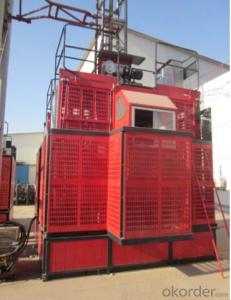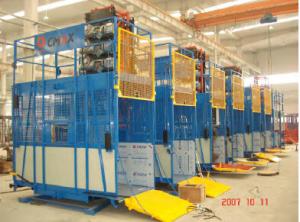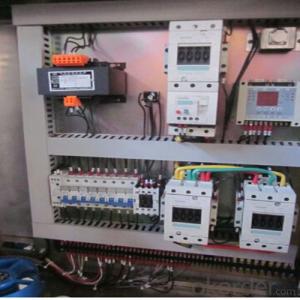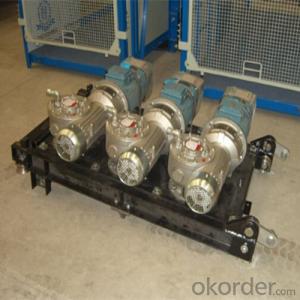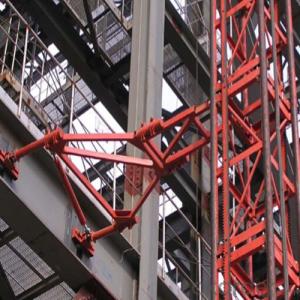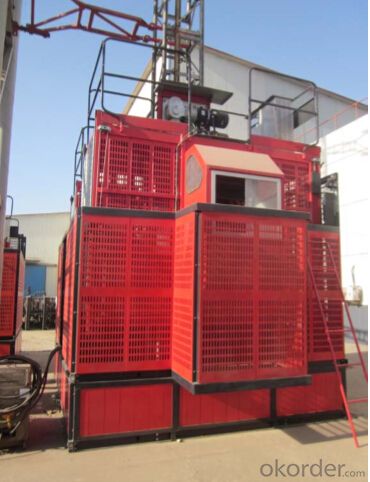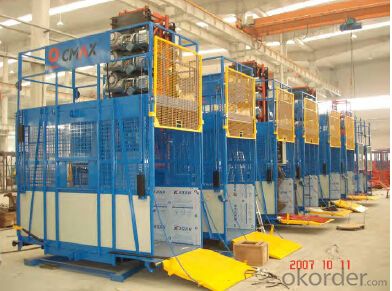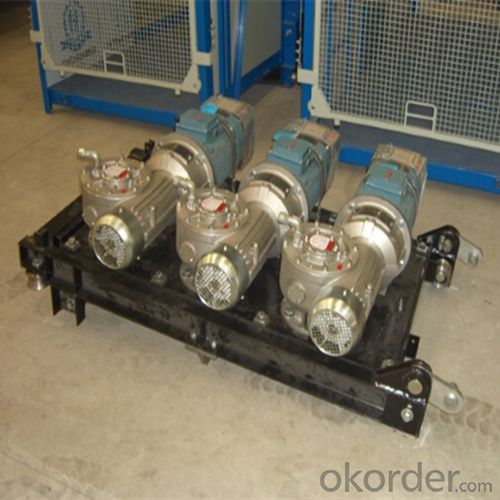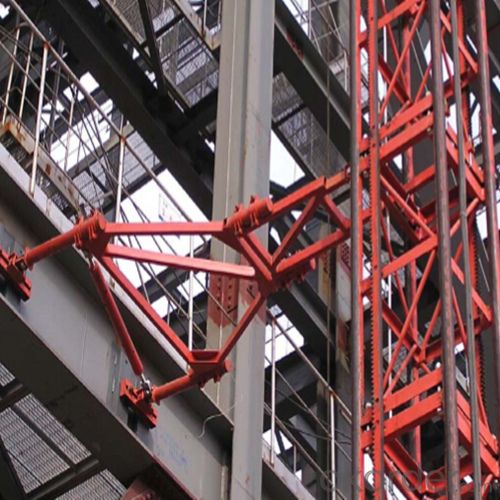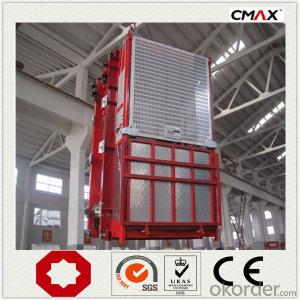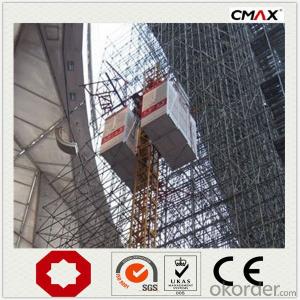construction hoist max capacity 2000 kg
- Loading Port:
- China main port
- Payment Terms:
- TT OR LC
- Min Order Qty:
- 1 unit
- Supply Capability:
- 30 unit/month
OKorder Service Pledge
OKorder Financial Service
You Might Also Like
Structure of Construction Hoist Description
Feature: Construction Hoist Condition: New Application: Construction
Payload(kg):2000 Lifting Speed(m/min):33 Motor Power(kw): 3*11
Safety Device: SAJ40-1.2 Cage: Single Counterweight: No
Certification: CE,ISO Place of Origin: China(Mainland) Model Number: Type:SC200
Packaging & Delivery of Construction Hoist
Packaging Detail: Nude package Delivery Detail: 25-30days
Main Parts of Construction Hoist
● The gearing adopts imported bearing, enameled cable, and oil seal.
● The electric parts adopt products from world renowned manufactures such as Schneider, Siemens, and LG.
● The racks and pinion adopts special material and heat-treatment technique, which prolong the life of these parts.
● The steel structure uses quality steel from famous domestic manufactures.
● The surface of the structure can apply paint-spray, parkerozing baking finish or hot galvanizing processing according
to users requirements,
● The cage can be produced and decorated by aluminum molded board, punched-plate or figured aluminm board.
Construction Hoist Specifiction
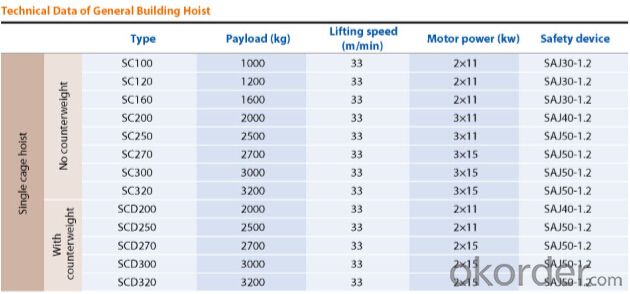
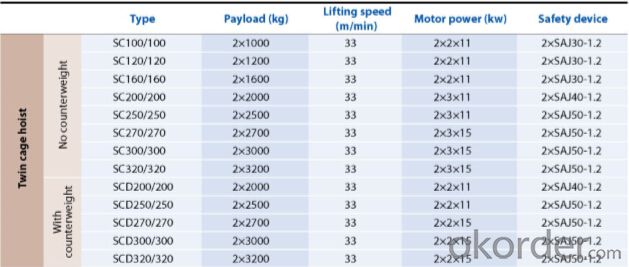
FAQ of Construction Hoist
Q: What is the building hoist main purpose?
A: Building hoist equipped with double or single cabin to transport the materials and labors up and down. It's the ideal
construction equipment for vertical transportation in the field of construction.
Q: What is the main structure of building hoist?
A: The P/M construction hoist mainly contains metal structure, driving system, electrical control system, cable guide &
protection system, electrical top crane and safety device.
Q: What is the meaning of the building hoist’s code?
A: Take SC200/200 for example: “SC” stands for rack and pinion hoist, “200/200” stands for double cage and capacity
is 2 tons per cage. “SC200” stands for single cage and capacity is 2 tons.
Q: What is the dimension of the cage?
A: Normally the cage dimension is 3X1.5X2.5M (L/W/H) for 2t type hoist. Details should be checked according to our
quotation sheet. Also, the size can be customized according to the factual site condition. There are two doors (entrance
& exit doors) for each cage, It can be produced as up & down sliding or ramping model for safety and convenience.
- Q: This question asks about the measures taken to guarantee the safety and reliability of lifting equipment prior to its use in construction.
- <p>To ensure that lifting equipment is safe and reliable before using it in construction work, several key steps must be taken. Firstly, regular inspections and maintenance are crucial to identify any potential issues or wear and tear. Secondly, all equipment should be thoroughly tested and certified by qualified personnel to meet safety standards. Thirdly, proper training for operators is essential to ensure they understand how to use the equipment safely. Additionally, having a comprehensive safety plan in place, including emergency procedures, can help prevent accidents. Lastly, using equipment from reputable manufacturers and ensuring all components are in good working order are also vital for maintaining safety and reliability.</p>
- Q: This question asks about the typical issues that can arise with building hoists, which are mechanical devices used in construction to lift materials and workers.
- <p>Common problems with building hoists include mechanical failures such as broken cables or chains, malfunctioning brakes, and worn-out gears. Electrical issues like short circuits or damaged control panels can also occur. Safety hazards may arise from improper installation or maintenance, leading to accidents. Overloading the hoist can cause structural damage and failure. Environmental factors like extreme weather conditions can affect performance and longevity. Regular inspections and maintenance are crucial to prevent these problems and ensure the safe operation of building hoists.</p>
- Q: Is it possible for a building hoist to lift more than one object simultaneously?
- <p>Yes, a building hoist can lift multiple objects at once, provided the combined weight does not exceed the hoist's maximum load capacity. The hoist's design and specifications will dictate how many and what types of objects can be lifted simultaneously. It's crucial to follow the manufacturer's guidelines to ensure safety and prevent damage to the hoist or the objects being lifted.</p>
- Q: Can a building hoist experience failure due to mechanical problems or the natural aging process?
- <p>Yes, a building hoist can malfunction due to mechanical issues or wear and tear. Mechanical problems can arise from various factors such as poor maintenance, overloading, or manufacturing defects. Wear and tear, which is the gradual deterioration of a machine's parts over time, can also lead to malfunctions. Regular inspections and maintenance are crucial to identify and rectify these issues, ensuring the safety and efficiency of the hoist operation.</p>
- Q: Does the new approach builder need a localizer test report
- When the distance of the meter cage is not more than the distance shown in the test, the safety device meets the requirements of the relevant specification. You're talking about a construction elevator that's the kind of gear rack that you don't want to have as long as you want to
- Q: Is it feasible to repair or replace a building hoist with ease?
- <p>The ease of repairing or replacing a building hoist depends on several factors. For minor issues, repairs can often be done relatively easily by trained technicians. However, for major malfunctions or when a hoist is outdated, replacement might be necessary. This process can be complex and requires expertise to ensure safety and compliance with building codes. Factors such as the hoist's age, the complexity of the system, and the availability of replacement parts play a significant role in determining the ease of repair or replacement. In some cases, it might be more cost-effective to replace rather than repair, especially if the hoist is old or if repair costs are high.</p>
- Q: What are the essential maintenance tasks and checks required to keep a hydraulic building hoist in good working condition?
- <p>Regular maintenance of a hydraulic building hoist is crucial for safety and efficiency. Key requirements include inspecting and lubricating moving parts, checking for leaks in hydraulic lines and seals, ensuring the hoist's load limit is not exceeded, and verifying the operation of safety devices like limit switches and emergency stops. Additionally, the hydraulic fluid should be checked for contamination and changed as needed, typically every 1000 hours of operation or annually. The electrical system should be inspected for any damage or wear, and all controls should be tested for proper functionality. A thorough inspection by a qualified technician is recommended at least once a year to ensure all components are in compliance with safety standards.</p>
- Q: This question asks for criteria to differentiate between electric and hydraulic building hoists for selection based on specific needs.
- <p>When choosing between electric and hydraulic building hoists, consider the following: 1) Power Source: Electric hoists require a reliable electricity supply while hydraulic hoists need a power source for the hydraulic pump. 2) Lifting Capacity: Electric hoists often have higher lifting capacities. 3) Speed: Electric hoists generally offer faster lifting and lowering speeds. 4) Maintenance: Hydraulic hoists may require more frequent maintenance due to fluid changes and potential leaks. 5) Noise: Electric hoists are quieter. 6) Cost: Initial costs and operating expenses should be compared. 7) Safety: Both types have safety features, but electric hoists might offer more advanced safety options. 8) Environmental Factors: Consider weather conditions; electric hoists are less affected by rain and cold. Your choice should align with the project's specific requirements, such as the weight of materials to be lifted, frequency of use, and environmental conditions.</p>
- Q: This question asks about the safety mechanisms or features that are included in a hydraulic building hoist to ensure its secure operation.
- <p>Hydraulic building hoists are equipped with several safety features to ensure secure operation. These include overload protection to prevent the hoist from lifting more weight than it is designed for, emergency stop buttons for immediate cessation of operations, safety hooks or shackles to secure the load, and lower limit switches to prevent over-lowering. Additionally, they often have a fail-safe valve system that locks the hoist in place if pressure is lost, and a cage or gate to protect operators from falling objects. Regular maintenance and inspection are also crucial for maintaining the safety of these hoists.</p>
- Q: Is it possible to utilize building hoists for the transportation of materials and equipment within construction sites?
- <p>Yes, building hoists are commonly used in construction sites to move materials and equipment. They are designed to lift and lower heavy loads vertically, making them ideal for transporting construction materials, tools, and equipment between different floors or levels of a building under construction. This equipment significantly enhances efficiency and safety on construction sites by reducing manual labor and the risk of accidents associated with manual handling of heavy items.</p>
Send your message to us
construction hoist max capacity 2000 kg
- Loading Port:
- China main port
- Payment Terms:
- TT OR LC
- Min Order Qty:
- 1 unit
- Supply Capability:
- 30 unit/month
OKorder Service Pledge
OKorder Financial Service
Similar products
Hot products
Hot Searches
Related keywords
